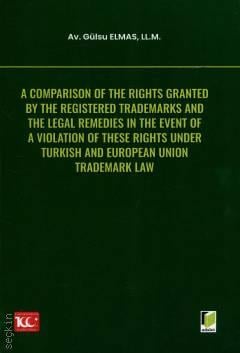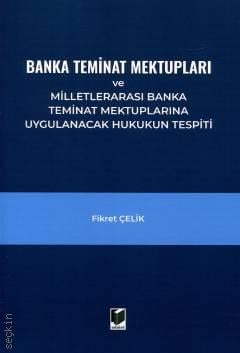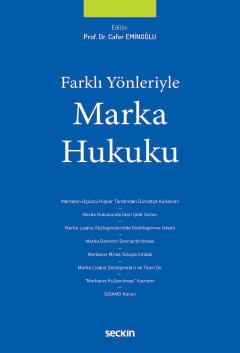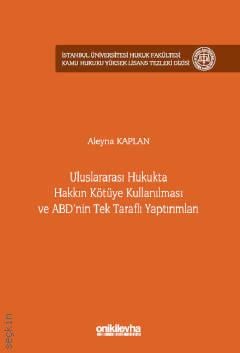>
Hukuk Kitapları>
Uluslararası Hukuk>
A Comparison of the Rights Granted By the Registered Trademarks and the Legal Remedies in the Event of a Violation of These Rights under Turkish and European Union Trademark Law

A Comparison of the Rights Granted By the Registered Trademarks and the Legal Remedies in the Event of a Violation of These Rights under Turkish and European Union Trademark Law
1. Baskı,
Mayıs 2024
Kitabın Detayları
Dili:
Türkçe
Ebat:
16x24
Sayfa Sayısı:
143
Kitabın Fiyatı:
290,00₺
Temin süresi 2-3 gündür.
Kitabın Açıklaması
In this study, I discuss Turkish Trademark Law and European Union Trademark Law. In Turkish Trademark Law, trademarks are primarily protected by the Industrial Property Law No. 6769 and the Regulation on the Implementation of the Industrial Property Law, whereas in the Trademark Law of the European Union, trademarks are protected by EU Trademark Directive No. 2015/2436, EU Trademark Regulation No. 2017/1001, EU Directive No. 2015/2436 and EU Directive No. 2004/48.
As a consequence of the increasing value of trademarks, the issue of unauthorized use of the trademark and its value by third parties has emerged. These unauthorized uses by third parties, known as trademark infringement, cause economic and reputational damage to the owners of the trademark. For this reason, trademark owners must understand the scope of their rights, which actions comprise an infringement of trademark rights, and the legal recourses available to them in such a situation. In different legal systems, the scope of the trademark right at issue, the acts that infringe on the trademark right and the available legal remedies may vary. By comparing Turkish and European Union Trademark Law regulations, these issues will be discussed in this research.
Kitabın Konu Başlıkları
Legal Regulations Regarding Trademark Law
General Information About Trademark Rights
Infringement of Trademark Rights
Legal Remedies for the Trademark Owner Whose Rights Have Been Infringed
Procedural Aspects of Trademark Infringement Cases
Crimes Involving Trademarks as a Result of Trademark Infringement
Kitapla İlgili Kategoriler
Yorumlar
Kitabın İçindekileri
TABLE OF CONTENT
ÖNSÖZ
7
TABLE OF CONTENT
9
LIST OF ABBREVIATIONS
13
INTRODUCTION
15
PART I
LEGAL REGULATIONS REGARDING
TRADEMARK LAW
I. RESOURCES OF EUROPEAN UNION TRADEMARK LAW
17
II. RESOURCES OF TURKISH TRADEMARK LAW
19
PART II
GENERAL INFORMATION ABOUT
TRADEMARK RIGHTS
I. DEFINITION OF TRADEMARK
23
II. TRADEMARK RIGHT
25
A. Characteristics of Trademark Right
25
1. Intangible Characteristic
25
2. Monopolistic Condition
26
3. Timeliness and Renewability
26
4. Being Subject to Legal Actions
27
5. Principle of Territoriality
28
6. Based on Voluntariness
30
7. Principle of Exhaustion
30
B. The Scope of Trademark Right
32
III. METHODS OF ACQUISITION OF TRADEMARK RIGHTS
35
A. The Acquisition of the Trademark Right By Way of Use
36
B. The Acquisition of the Trademark Right By Way of Use Registration
38
C. The Acquisition of the Trademark Right under Turkish and
European Unıon Trademark Law
40
PART III
INFRINGEMENT OF TRADEMARK RIGHTS
I. PREREQUISITE LEGAL CONDITIONS FOR TRADEMARK
INFRINGEMENT
43
A. Use of the Trademark without the Owner’s Consent
43
B. Use of the Trademark for Commercial Purposes
44
C. Use of the Trademark in the Protection of the Trademark
44
D. Use of the Trademark Where it is Registered
45
II. ACTIONS INFRINGING A TRADEMARK RIGHT
46
A. Unauthorized Use of Trademark
49
1. Use of a Sign Identical to a Registered Trademark for the
ProductsServices Covered by the Registration
50
2. The Use of any Sign That İs İdenticalConfusingly Similar
to the Registered Trademark and That Covers the Same or
Similar GoodsServices as the GoodsServices Covered
by the Registered Trademark, and Therefore İs Likely To
Cause Confusion Among the Public, İncluding the Possibility
of Association With the Registered Trademark.
50
a. Similarity of Trademarks
53
b. Similarity between Trademark Classes
53
c. Customer Perception
54
d. The Distinctive Power of the Trademark
54
e. Likelihood of Association
54
f. Holisticuation
55
3. Unjustified Use of a Sign That İs İdenticalSimilar to a
Registered Trademark and That Would Gain an Unfair
Advantage From the Reputation of the Trademark Due to
the Level of Recognition İt Has Achieved,That Would
Harm its ReputationDamage İts Distinctive Character,
Regardless of Whether the GoodsServices Are the
Same, Similar,Different
56
a. Existence of a Reputable Trademark
56
b. The Impact of Unauthorized Use on Reputable
Trademark
59
(1) Gaining a Unjust Advantage
59
(2) Damage to the Reputation of the Trademark
59
(3) Damage to the Distinctiveness Character of
the Trademark
60
B. Affixing the Sign to the Goodsto the Packaging of Those Goods
60
C. ImportingExporting Goods Bearing the Registered
Trademarka Similar Mark without Authorization
61
D. Putting the Goods on the Market, Offering Them as
Deliverable,Stocking Them for These Purposes under the
Sign,OfferingSupplying Services
65
E. Using the Registered Trademarka Similar Mark in
Advertising, Promotion,Online Activities
69
F. Use the Sign in Comparative Advertisements
73
G. Use of the Sign as a Trade NameCompany Name
74
H. ExtendingTransferring Rights to Third Parties Without the
Licensor’s Permission
75
1. Regarding Duration
77
2. Regarding Location
77
3. Regarding Quantity
78
4. Regarding Products and Services
78
5. Through Sub–Licensing
78
PART IV
LEGAL REMEDIES FOR THE TRADEMARK OWNER
WHOSE RIGHTS HAVE BEEN INFRINGED
I. REQUEST FOR DETECTION OF INFRINGEMENT
81
II. REQUEST TO PREVENT THE POSSIBILITY INFRINGEMENT
82
III. REQUEST TO TERMINATE THE INFRINGEMENT
82
IV. REQUEST FOR REPRESENTATION OF INFRINGEMENT
83
V. REQUEST FOR COMPENSATION
84
A. Material Compensation
84
B. Non–Material Compensation
89
C. Reputation Compensation
90
VI. ADDITIONAL CLAIMS THAT MAY BE MADE BY THE TRADEMARK
OWNER
92
A. Confiscation Of Products and Other Properties
92
B. Request To Take the Necessary Measures to Prevent the
Continuation of Infringement
93
C. Announcement of the Ruling and Notification to Related Parties
94
D. Interim Measures and Customs Seizure
95
1. Interim Measures
95
2. Customs Seizure
96
PART V
PROCEDURAL ASPECTS OF TRADEMARK
INFRINGEMENT CASES
I. PARTIES TO THE ACTION OF TRADEMARK INFRINGEMENT
101
A. Complainant
101
1. The Owner of the Trademark
101
2. Licensee
102
a. Non– Exclusive Licensee
104
b. Exclusive Licensee
105
3. Owner of the trademark as exclusive licensor
105
4. Lienor
106
5. Owner of a Well–Known Trademark under the Paris
Convention
107
B. Defendant
107
1. RealLegal Person Performing Prohibited Actions of
Infringement
107
2. Licensee
108
3. Those Who Participate in, Assist in, Encounter or
Facilitate Infringement
108
4. Persons Who Cannot Be Claimed due to Infringement of
the Trademark
109
VII. COMPETENT COURTS IN CASE OF TRADEMARK INFRINGEMENT
113
VIII. STATUTE OF LIMITATIONS
116
IX. MEDIATIONMENTPRIORTOFILINGALAWSUITINCOURT
117
PART VI
CRIMES INVOLVING TRADEMARKS AS A RESULT OF
TRADEMARK INFRINGEMENT
119
CONCLUSION
121
BIBLIOGRAPHY
135
Kitabın Fiyatı:
290,00₺
Temin süresi 2-3 gündür.
Bu kitaplar da ilginizi çekebilir
Hakkımızda
|
Uluslararası Yayınevi Belgesi|
Kaynakça Dosyası|
Kişisel Verilerin Korunması |
Üyelik|
Siparişlerim|
İade Politikası|
İletişim


